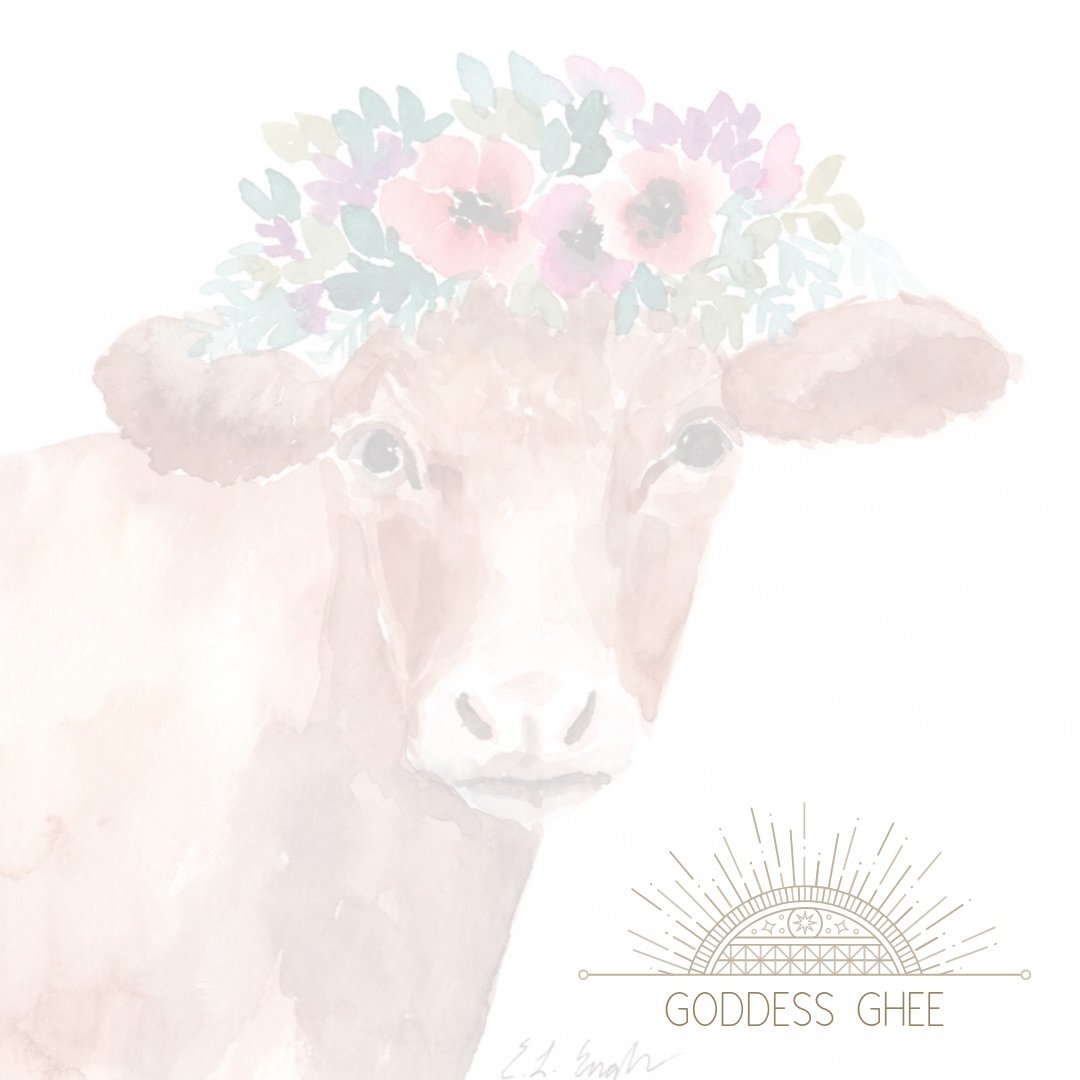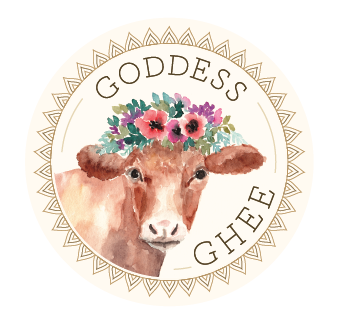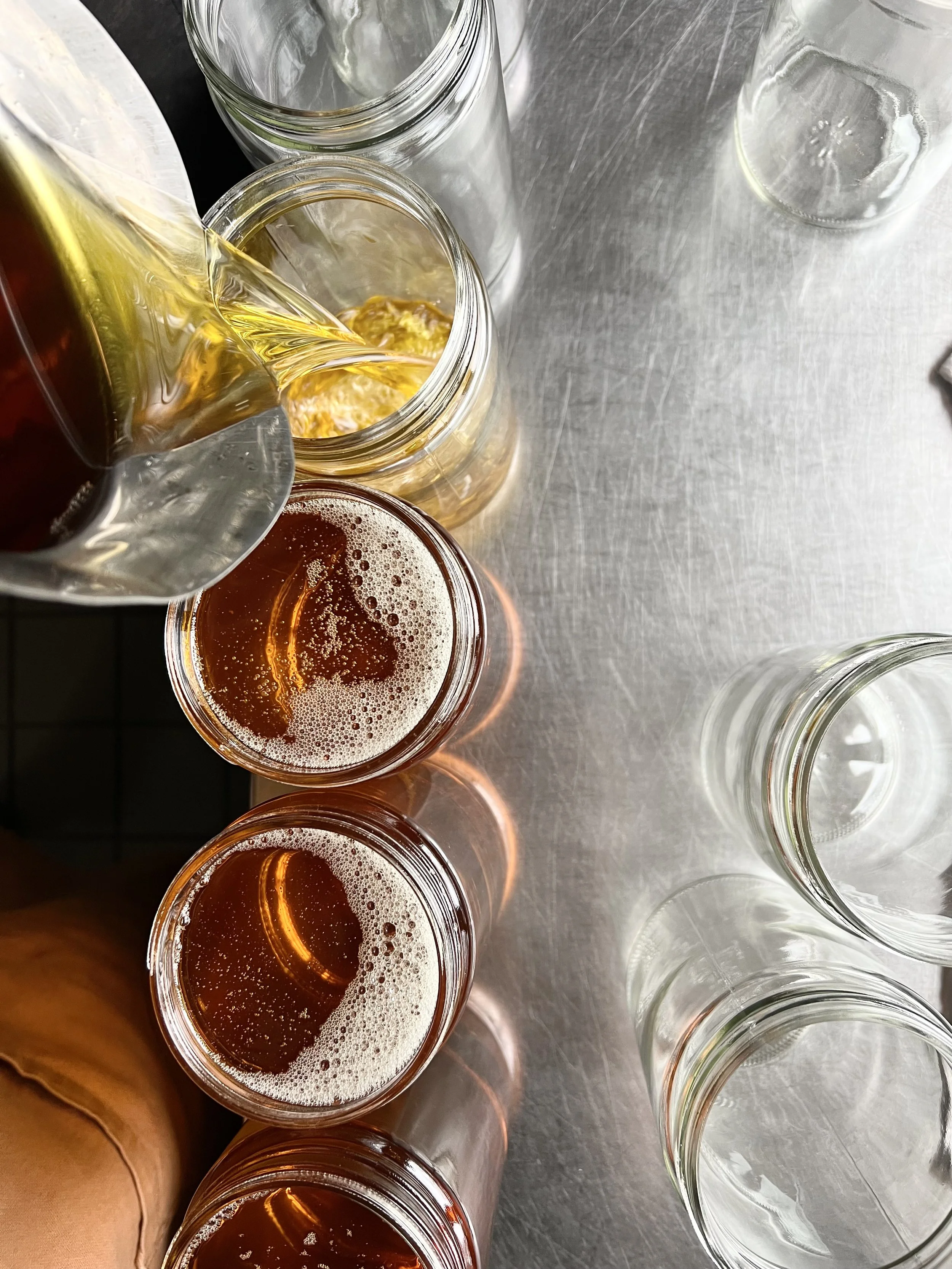
FAQs
What is ghee?
Ghee is a traditional and sacred food and a staple of Ayurvedic medicine, an ancient tradition of medicine which prioritizes the healing powers of food. . It is essentially pure caramelized butter oil.
Is ghee the same as clarified butter?
No. Most commercial ghee brands make “clarified butter” in giant enclosed steam kettles and label it “ghee”. Because all of the moisture isn’t evaporated using this method it runs the risk of becoming rancid.
Clarified butter is made in the same way that ghee is made, but ghee is taken a step further. Clarified butter is what is made when the milk solids separate from the butter, leaving a clarified butter oil. It becomes ghee after the milk solids have been caramelized, giving the ghee a nutty and toasty flavor. This process also ensures that all moisture is evaporated from the oil.
How long will Goddess Ghee remain shelf stable?
If ghee is sealed well and doesn't acquire moisture it will keep without refrigeration for 3 months. If it's kept sealed and refrigerated it will keep for up to a year. We recommend storing in cool, dark, & dry place in the kitchen- like a pantry or shelf and always use a clean, dry utensil.
What is the difference between ghee and “high vitamin butter oil”?
You may be familiar with a product called “high vitamin butter oil” that was popularized by the Weston A Price foundation. High Vitamin Butter Oil (HVBO) is essentially butter oil that is made from butter that comes from cows who eat green grass. This makes the butter high in Vitamins, especially K, A, D, and E. Some brands use a cold centrifuge process that extracts the oil from the butter without heat, but we find this process to create rancidity, and from our research the Vitamins are not destroyed in the heating process. This is why we sometimes call Goddess Ghee “High Vitamin Butter Oil”.
Where does ghee originate from?
Ghee is most commonly known in India and Nepal. Ayurveda has an ancient history of championing ghee as the healthiest source of edible fat, considering it a vital food for optimal digestion, vibrant skin, bioavailability of nutrients (aiding in nutrient assimilation into our bodies), and mental clarity. However, the process of clarifying butter as a method of preservation is ancient and has been found in most cultures around the world that practice milking animals.
How is ghee made?
Ghee is made by slowly simmering butter until the moisture evaporates and the milk solids/proteins are toasted and separated.
What are the health benefits of ghee?
Ghee made from cultured butter from the milk of grass-fed cows is exceptionally healthy! It is loaded with vitamins A, D, E, and K. It is also rich in butyric acid helpful for supporting healthy gut microbiomes & balanced gastrointestinal system. Ghee made from organic butter sourced from pasture-raised cows is also a natural source of conjugated linolenic acid (CLA), which is indicated to slow the progression of heart disease and some types of cancer. Ghee sourced from pastured cows additionally contains Omega 3 and Omega 9 fatty acids, which most people are generally deficient in. These fatty acids have been indicated as crucial to proper hydration, literally helping our cells to retain more water. Ghee is remarkably bioavailable, long prized for increasing nutrient absorption of fat-soluble vitamins and minerals from the foods and herbs with which it is paired. Actually able to pass through the lipid membranes of our cells, the nutrients that accompany foods and herbs cooked in, paired with, or infused into ghee can penetrate deeply into our bodies. For this reason, ghee has a long history of being used as a carrier oil (menstruum) for medicinal, herbal preparations.
What are other benefits of ghee?
Ghee has one of the highest smoke points of any oils available, at 485 degrees or more (regular butter has a smoke point of 350 degrees, while olive oil's is 370). When oil reaches its smoke point and beyond, it oxidizes and releases highly reactive compounds called free radicals are created, which are harmful to the body's cells. Some studies have shown that consuming oxidized oils increases inflammation, which may damage your DNA and can make you more vulnerable to Alzheimer's disease, diabetes, heart disease, and cancer." The high smoke point of ghee makes it an excellent oil for deep frying, sautéing, baking, and roasting.
I’m dairy intolerant. Can I eat ghee?
Typically if someone has a dairy intolerance, it is an intolerance to casein (a protein in milk) and lactose (the whey). Ghee contains neither. When prepared in the tradition of Ayurveda, the casein and lactose are removed, therefore making ghee tolerable for those who can't eat dairy otherwise. Goddess Ghee is made with cultured butter (already low in lactose) and is cooked to perfection so that it is lactose and casein free.
What do you mean by “grass fed”?
"Grass-fed" means that the butter we source to make our ghee is made from the milk from cows who eat grass. These cows are outside on green pastures all year long. This is important because the grass provides the cows complete nutrition.
What are the Nutrition Facts?
For all unsweetened ghee:
Serving size: 1 Tbsp (13g), Amount Per Serving: Calories 120, Total Fat 14g (18% DV), Saturated Fat 9g (45% DV) Trans Fat 0g, Cholesterol 35mg (12% DV), Sodium 0mg, Total Carbohydrate 0g, Dietary Fiber 0g, Total Sugars 0g, Protein 0g. Percent Daily Values are based on a 2,000 calorie diet.
For all honey blends:
Serving size: 1 Tbsp (13g), Amount Per Serving: Calories 120, Total Fat 14g (18% DV), Saturated Fat 9g (45% DV) Trans Fat 0g, Cholesterol 35mg (12% DV), Sodium 0mg, Total Carbohydrate 0g, Dietary Fiber 0g, Total Sugars <1g, Protein 0g. Percent Daily Values are based on a 2,000 calorie diet.
9oz: 17 servings, 16oz: 34 servings, 32oz: 68 servings, 64oz: 136 servings
My jar arrived grainy in texture or separated due to heat while transporting. Can I fix it?
Sometimes separation happens during shipment. If you’d like to restore it to it’s smooth consistent texture, you can scoop it into a saucepan, gently warm it on the stove, and then pour it back into the jar and place it in a cool place (the refrigerator or on a cold day outside). Once it’s re-solidified you can keep it at room temperature again.
If it’s one of our blended ghee varieties you will need to mix it back up while its a thick consistency before placing it in the fridge.
Our Butter Source
Our butter source is Banner Butter, a source regional to us. Banner butter churns local grass fed cultured butter in Atlanta, GA.
From Banner Butter's Website:
"Who are we? We're not them. While industrial scale butters are made with unripened cream and added "natural" flavoring, Banner Butter, a small-batch butter, is made with patiently-cultured cream from hormone-free, grass-fed cows with no added flavoring. We go big, but only in taste. Everything else is small, simple and slow."
What makes banner butter different?
“We’re different in several ways. First, the cream. It’s fresh. Like, really fresh. That’s because it comes from Georgia cows, local to us. Second, it’s grass-fed. Our cows graze in green pastures and are not treated with hormones. Third, the butterfat. We make butter that is has a higher proportion of butterfat other butters. Fourth, the method. Before churning, we let the cream ripen for many, many hours. This ripening process allows good bacteria to form. It is this good bacteria that gives butter its complex buttery undertones. Next, after the cream ripens, we slowly churn it in small batches. This process results in a better tasting product because we are able to make small adjustments throughout churning, depending on the season, the consistency, and the taste of the cream. In the end, it takes us 20 times longer to make our butter than industrial scale butters.”
What is cultured butter?
“The vast majority of butter sold in America is sweet cream butter. That means that, after the cream is pasteurized, it is immediately churned. That also means that it has very little taste. So, to give it flavor, many butter manufacturers add “natural flavoring,” or “lactic acid.” Butter churned from sweet cream lacks the flavors that can only come from a long-ripening process where a special mixture of bacteria is added to the cream and held at precisely the right temperature, for precisely the right amount of time. This good bacteria is one of the things that makes our butter taste so good. Let’s reclaim the way butter should be, shall we?”
Can you tell me about how the cows are treated?
We use cream from local cows that graze in green pastures on small farms. Free-ranging cows tend to live longer, healthier lives and produce wonderfully flavorful cream. Our dairy farms also never dose their cows with hormones to increase milk production; a practice that can cause health problems in cows and humans alike.
Are your butters organic?
No, they are not. Some of our small dairy farmers often choose not to seek organic certification for cost or resource reasons. But they have pledged to avoid unsustainable farming practices and unnecessary use of pesticides.
Why should I care that Banner Butter is made from grass-fed cow’s cream?
A healthy share of grass in the cows’ diet not only pleases their taste buds, it increases conjugated linoleic acids, vitamin E, beta-carotene, and omega-3 fatty acids in the milk they produce, thereby benefitting the oh-so-lucky consumer.
I’m trying to be healthy. And everyone knows that butter is bad for you.
What do Time Magazine, Mark Bittman, and The Wall Street Journal all have in common? They’ve each recently recognized that we’ve been duped. Duped into thinking that fat – and butter – are the enemy. And being duped hurts. In so many ways. Check out what they say – ending the war on fat — so that we can set the record straight.
For more info on Banner Butter, visit http://bannerbutter.com/faqs/

